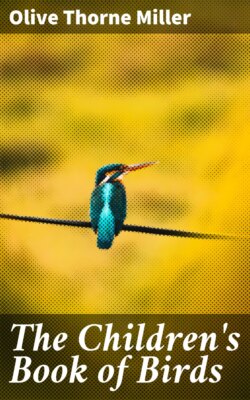Читать книгу The Children's Book of Birds - Olive Thorne Miller - Страница 10
На сайте Литреса книга снята с продажи.
III
ОглавлениеTable of Contents
THE BIRD'S HOME
Each bird mother has her own way of making the nest, but there is one thing almost all of them try to do, and that is to hide it.
They cannot put their little homes out in plain sight, as we do our houses, because so many creatures want to rob them. Squirrels and snakes and rats, and some big birds, and cats and many others, like to eat eggs and young birds.
So most birds try, first of all, to find good hiding-places. Some tiny warblers go to the tops of the tallest trees, and hide the nest among the leaves. Orioles hang the swinging cradle at the end of a branch, where cats and snakes and naughty boys cannot come. Song sparrows tuck the little home in a tuft of weeds, on the ground, and bobolinks hide it in the deep grass.
After a safe place is found, they have to get something to build of. They hunt all about and gather small twigs, or grass stems, or fine rootlets, and pull narrow strips of bark off the grapevines and the birch-trees, or they pick up strings and horsehairs, and many other things. Robins and swallows use mud.
BALTIMORE ORIOLE AND NEST
As they go on building, the mother bird gets inside and turns around and around to make it fit her form, and be smooth and comfortable for her to sit in.
When a nest is made, it must be lined. Then some birds go to the chicken yard, and pick up feathers, and others find horsehairs. Some of them pull off the soft down that grows on plants, or get bits of wool from the sheep pasture, or old leaves from the woods, and make it soft and warm inside.
Some bird homes are only platforms, where it seems as if the eggs must roll off, and others are deep burrows, or holes in the ground, where no one can get in. Some are dainty baskets hung between two twigs, and others are tiny cups of felt with lichens outside.
Each species of bird builds in its own way. There are as many different ways to make nests as there are kinds of birds to make them.
Then after all the trouble birds have taken to build a nest, they seldom use it a second time. If a pair have two broods in a season, they almost always build a new one for each family.
A few birds, such as eagles, owls, and sometimes orioles, and others, repair the home and use it again, and woodpeckers sometimes nest in the old holes. But generally, after the young birds have flown, we may be sure the nest will not be wanted again.
When the nest is finished, the eggs are laid in it, one by one. We all know how pretty birds' eggs are. Some are snowy white, some are delicate pink, and some blue. Many have tiny dots and specks on them, and a few are covered with queer-looking streaks and lines. But pretty as they are, I think no one would be so cruel as to take them away from the poor little mother, if he remembered that her young ones are inside them, and that she loves them as his own mother loves him.
I have heard people say that birds do not care for their eggs. Let me tell you what a little chickadee mother did when a man tried to steal the eggs out of her nest.
The nest was in a hole in an old stump, and the man could not get his hand in, so he had to take them out one at a time with a little scoop.
At first the mother flew at him and tried to drive him away. Then chickadees and other birds who lived near came to help her. All flew about his face with cries, so that he had to use one hand to keep them away from his eyes. But still he went on taking out the eggs.
At last the little mother was so wild with grief that she dashed into the hole and sat there in the doorway, right before his face. He could not get another egg without hurting her, and he was ashamed to do that.
This was as brave in the tiny creature as it would be for a human mother to throw herself before a fierce, hungry tiger. Do you think she did not care for her eggs?
